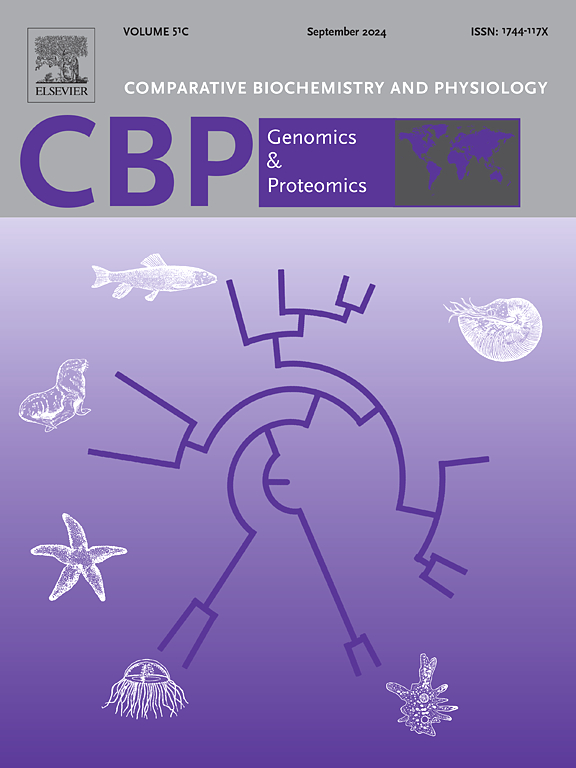贵族扇贝14-3-3基因家族的全基因组鉴定及其低温胁迫下的表达谱
IF 2.2
2区 生物学
Q4 BIOCHEMISTRY & MOLECULAR BIOLOGY
Comparative Biochemistry and Physiology D-Genomics & Proteomics
Pub Date : 2025-06-04
DOI:10.1016/j.cbd.2025.101562
引用次数: 0
摘要
14-3-3家族基因是真核生物中高度保守的调控因子,在细胞调控和逆境适应中发挥着重要作用。尽管对脊椎动物和一些水生物种进行了广泛的研究,但14-3-3基因在双壳类动物中的功能作用仍未得到充分的探索。本研究从贵族扇贝(Chlamys nobilis)中鉴定并鉴定了5个14-3-3基因(Cn14-3-3a ~ Cn14-3-3e)。系统发育和基序分析证实了它们的高度保守性,与它们在基本生物过程中的作用一致。组织特异性表达谱显示,这些基因主要在免疫相关组织中表达,如血液、鳃和肠道,表明它们参与免疫反应。此外,它们在急性和慢性低温胁迫下的表达动态突出了不同的调控模式:从25°C到9°C的急性低温暴露引起所有Cn14-3-3基因的显著上调(P <;0.05),而在慢性冷胁迫条件下,Cn14-3-3家族成员的表达谱表现出不同的模式。具体来说,Cn14-3-3a和Cn14-3-3b的表达水平在17°C时开始出现轻微上调。然而,随着温度的持续下降,它们的表达逐渐减少。而随着温度的降低,Cn14-3-3c的表达呈持续下降趋势。值得注意的是,Cn14-3-3d和Cn14-3-3e的表达相对稳定,在温度降低的情况下没有明显变化。这些发现对14-3-3基因在双壳类动物冷适应和免疫应答中的功能作用提供了新的认识,为提高水产养殖系统的耐寒性提供了策略基础。本文章由计算机程序翻译,如有差异,请以英文原文为准。

Genome-wide identification of 14-3-3 gene family and their expression profiles under low temperature stress in noble scallop Chlamys nobilis
The 14-3-3 family genes, highly conserved regulatory factors in eukaryotes, play critical roles in cellular regulation and stress adaptation. Despite extensive research in vertebrates and some aquatic species, the functional roles of 14-3-3 genes in bivalves remain underexplored. In this study, we identified and characterized five 14-3-3 genes (Cn14-3-3a to Cn14-3-3e) in the noble scallop Chlamys nobilis. Phylogenetic and motif analyses confirmed their high conservation, consistent with their roles in essential biological processes. Tissue-specific expression profiling revealed that these genes are predominantly expressed in immune-related tissues such as the blood, gills, and intestine, suggesting their involvement in immune responses. Furthermore, their expression dynamics under acute and chronic low-temperature stress highlighted distinct regulatory patterns: acute cold exposure from 25 °C to 9 °C elicited significant upregulation of all Cn14-3-3 genes (P < 0.05), while under chronic cold stress conditions, the expression profiles of Cn14-3-3 family members exhibited distinct patterns. Specifically, the expression levels of Cn14-3-3a and Cn14-3-3b initially showed a slight upregulation at 17 °C. However, as the temperature continued to decline, their expression gradually diminished. In contrast, the expression of Cn14-3-3c displayed a continuous downward trend with decreasing temperature. Notably, the expression of Cn14-3-3d and Cn14-3-3e remained relatively stable, showing no significant changes in response to temperature decreased. These findings provide novel insights into the functional roles of 14-3-3 genes in the cold adaptation and immune responses of bivalves, offering a foundation for strategies to enhance cold tolerance in aquaculture systems.
求助全文
通过发布文献求助,成功后即可免费获取论文全文。
去求助
来源期刊
CiteScore
5.10
自引率
3.30%
发文量
69
审稿时长
33 days
期刊介绍:
Comparative Biochemistry & Physiology (CBP) publishes papers in comparative, environmental and evolutionary physiology.
Part D: Genomics and Proteomics (CBPD), focuses on “omics” approaches to physiology, including comparative and functional genomics, metagenomics, transcriptomics, proteomics, metabolomics, and lipidomics. Most studies employ “omics” and/or system biology to test specific hypotheses about molecular and biochemical mechanisms underlying physiological responses to the environment. We encourage papers that address fundamental questions in comparative physiology and biochemistry rather than studies with a focus that is purely technical, methodological or descriptive in nature.

 求助内容:
求助内容: 应助结果提醒方式:
应助结果提醒方式:


